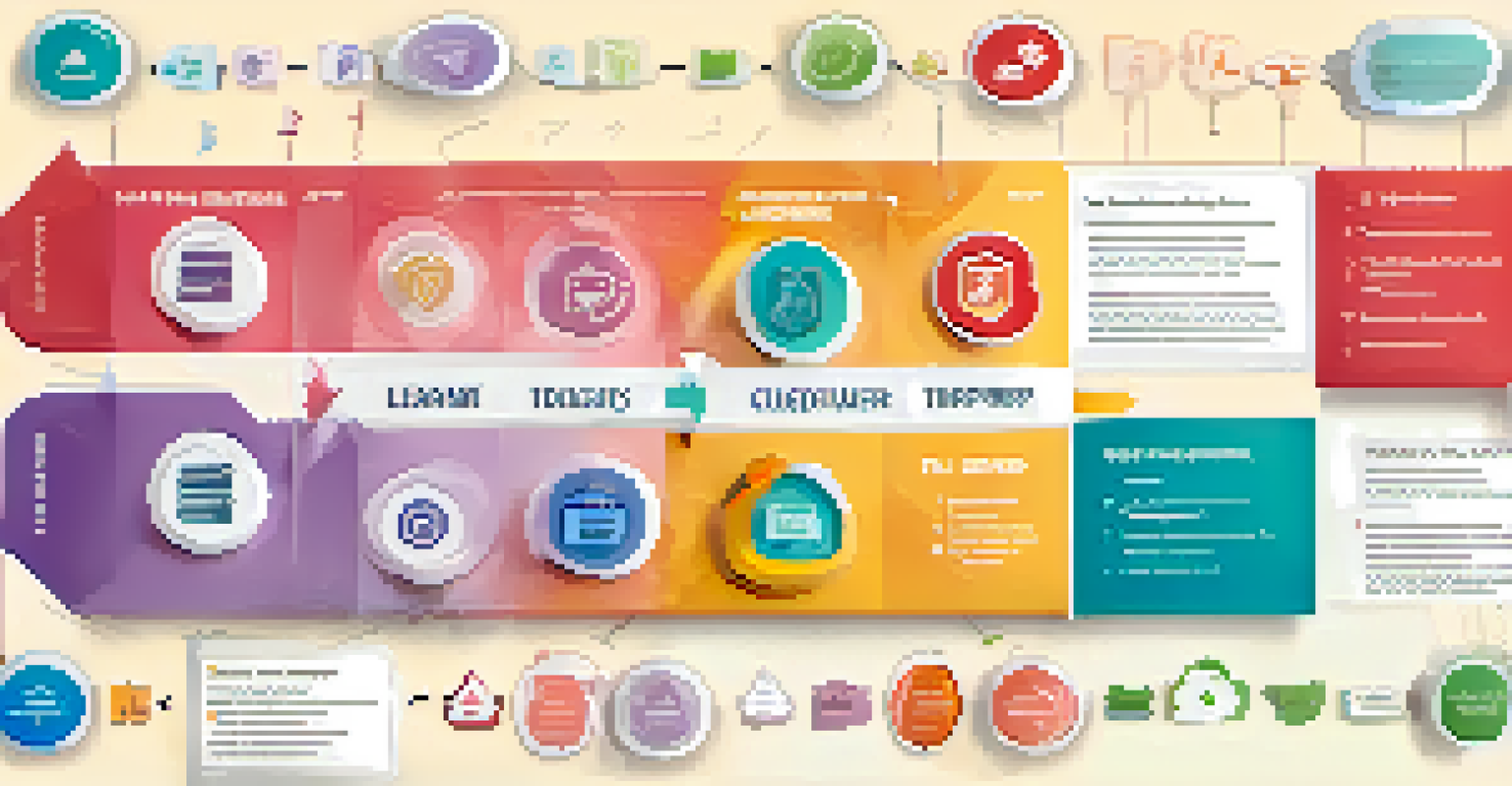Open Badges: Transforming Learning Into Credentials

Understanding Open Badges and Their Purpose
Open Badges are digital representations of skills and achievements, designed to showcase what individuals have learned. They serve as a way to validate knowledge gained through diverse experiences, whether formal education or self-directed learning. Think of them like digital stickers that you can earn for completing tasks, mastering skills, or engaging in projects.
The future belongs to those who believe in the beauty of their dreams.
These badges are not just pretty images; they contain metadata that provides context about the criteria met, the issuer, and the date earned. This transparency makes them a powerful tool for recognition, providing evidence of capabilities in a way that traditional certificates often cannot. By tapping into the digital nature of badges, learners can easily share their accomplishments online, making it simpler for employers and peers to understand their qualifications.
The rise of Open Badges signifies a shift towards a more inclusive and personalized approach to education. No longer confined to grades or degrees, learners can now showcase a full spectrum of their skills, making their educational journeys visible and accessible. This is especially beneficial in today's fast-paced world, where continuous learning and adaptability are essential.
The Benefits of Using Open Badges
One of the key advantages of Open Badges is their ability to provide a more granular view of a learner's achievements. Unlike traditional credentials that often lump various skills together, badges allow for the recognition of specific skills in isolation. This can be particularly useful for industries that require niche skills, making it easier for employers to identify qualified candidates.

Open Badges also promote lifelong learning by encouraging individuals to pursue personal and professional development actively. When learners know they can earn a badge for mastering a new skill, they are often more motivated to engage with the material. This can lead to a culture of continuous improvement, where individuals regularly seek out opportunities for growth.
Open Badges Enhance Skill Recognition
Open Badges provide a digital way to validate specific skills and achievements, making it easier for employers to identify qualified candidates.
Furthermore, Open Badges empower learners by giving them ownership of their credentials. Instead of relying solely on institutions to validate their skills, individuals can curate their achievements and present them as they see fit. This autonomy can boost confidence and enhance a learner's professional identity in an increasingly competitive job market.
How Open Badges Support Diverse Learning Pathways
Open Badges recognize that learning happens in various environments, not just in traditional classrooms. Whether someone learns through online courses, workshops, or even volunteer work, badges can validate these experiences. This flexibility makes them an appealing option for learners with diverse educational backgrounds.
Education is the most powerful weapon which you can use to change the world.
For example, someone might earn badges for completing a coding boot camp, volunteering at a local nonprofit, and participating in an online leadership course. Each badge tells a part of their story, demonstrating a multifaceted skill set to potential employers. This narrative approach to credentials is particularly valuable in a world that increasingly values practical experience over formal qualifications.
By embracing a variety of learning pathways, Open Badges foster a more inclusive educational landscape. They allow recognition of non-traditional routes to skill acquisition, ensuring that everyone, regardless of their background, has the chance to showcase their abilities. This inclusivity not only benefits individuals but also enriches the workforce as a whole.
The Role of Technology in Open Badges
Technology plays a pivotal role in the implementation and management of Open Badges. Digital platforms facilitate the creation, distribution, and verification of badges, making the entire process seamless for learners and issuers alike. When a learner earns a badge, it can be instantly shared on social media or embedded in a digital portfolio, enhancing visibility and credibility.
Moreover, the use of blockchain technology in some badge systems ensures that the credentials are tamper-proof and verifiable. This added layer of security protects against fraudulent claims and helps employers trust the legitimacy of the badges presented to them. As technology continues to evolve, so too will the possibilities for how badges can be issued and utilized.
Technology Powers Open Badges
The integration of technology, including blockchain and learning management systems, facilitates the creation, sharing, and verification of Open Badges.
In addition, learning management systems (LMS) are increasingly incorporating Open Badges into their frameworks. This integration allows educators to easily issue badges based on student performance, providing immediate recognition for achievements. As more institutions adopt this technology, the visibility and acceptance of Open Badges are likely to grow.
Open Badges in the Workplace: A New Hiring Paradigm
Employers are beginning to recognize the value of Open Badges as part of the hiring process. By considering badges alongside traditional resumes, employers can gain a clearer understanding of a candidate's skills and experiences. This shift can lead to more informed hiring decisions and a focus on competencies rather than just degrees.
For instance, a candidate with badges in project management, data analysis, and teamwork may stand out more than one who simply has a degree without specific skill indicators. This emphasis on practical skills can help organizations build more capable teams that can adapt to the demands of the modern workplace. As such, Open Badges are transforming the way employers evaluate talent.
Additionally, companies can use Open Badges for internal employee development, recognizing achievements in training and professional growth. By issuing badges for completed training programs or skill advancements, organizations can encourage continuous learning among their workforce. This not only boosts employee morale but also enhances the overall skill set of the company.
Challenges and Limitations of Open Badges
While Open Badges offer numerous benefits, they are not without challenges. One significant hurdle is the need for widespread recognition and acceptance of badges in various industries. Without a common understanding of what each badge represents, their value may be diminished, making it crucial for issuers to maintain high standards.
Another challenge is ensuring the quality and integrity of the badges being issued. As the popularity of Open Badges grows, so does the potential for misuse. It's essential for organizations issuing badges to have clear criteria and guidelines to prevent any devaluation of their badges through lax standards.
Inclusive Learning Pathways Emerged
Open Badges recognize diverse learning experiences, allowing individuals from various backgrounds to showcase their unique skill sets.
Lastly, there is the issue of accessibility. Not all learners have equal access to the technology or resources needed to earn Open Badges. Ensuring that all individuals, regardless of their background, can participate in this system is essential for it to be truly transformative in the educational landscape.
The Future of Open Badges and Credentialing
The future of Open Badges looks promising as more institutions and organizations recognize their potential. As the workforce evolves, the demand for skills-based hiring will likely continue to grow, paving the way for badges as a standard form of credentialing. This shift could lead to a more equitable job market, where diverse skills are valued alongside traditional educational backgrounds.
Moreover, as technology advances, we can expect to see more innovative uses for Open Badges. For example, integrating artificial intelligence could help personalize learning experiences and badge recommendations based on individual career goals. This tailored approach could further enhance the value of badges as individuals navigate their unique educational journeys.

Ultimately, Open Badges represent a shift towards a more inclusive and dynamic approach to learning and credentialing. By embracing these digital credentials, we can foster a culture that values diverse learning paths and recognizes the vast array of skills individuals bring to the table.